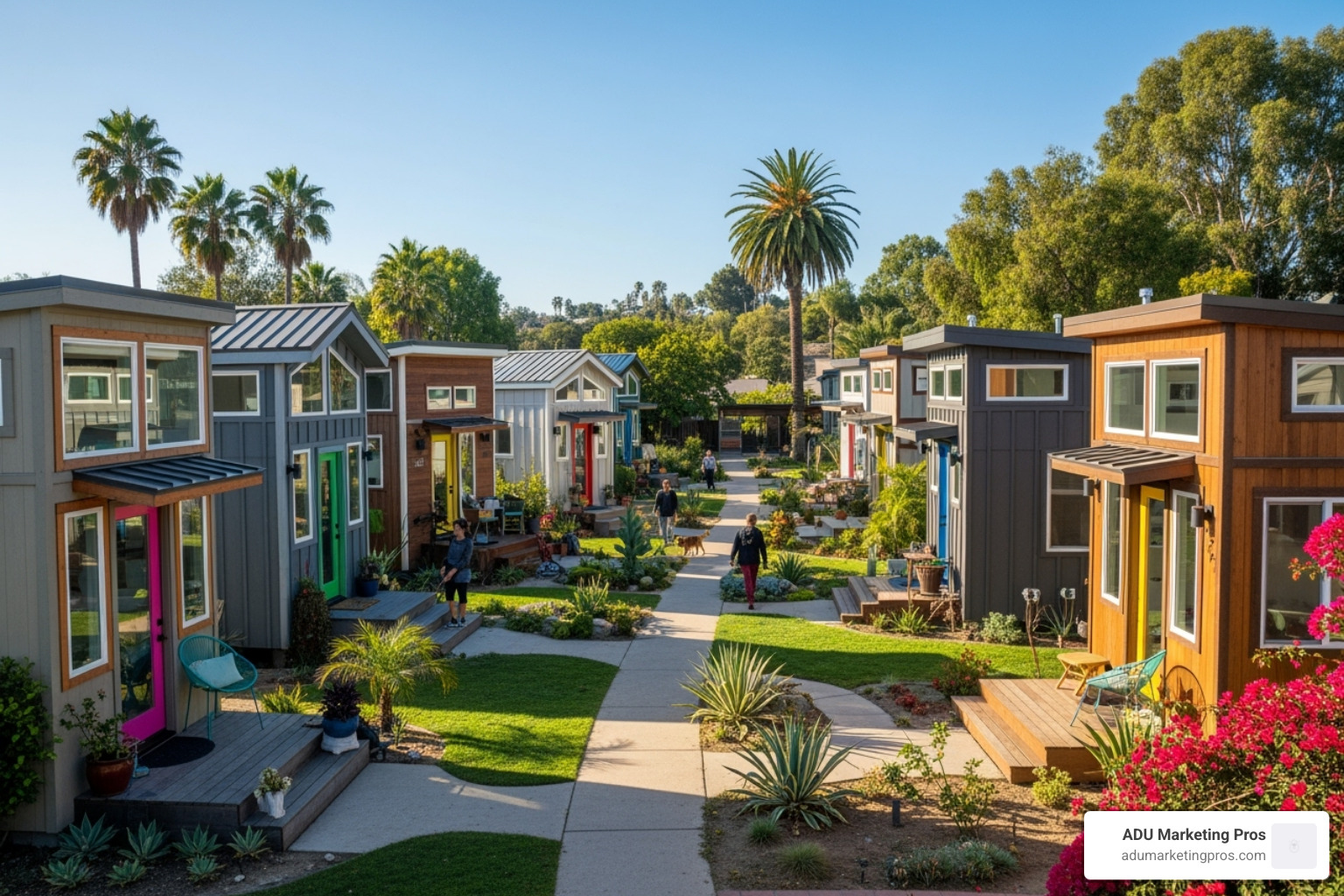Why Tiny Home Communities Are Changing Southern California Living
Tiny home communities in southern california are rapidly emerging as a vital and popular solution for a growing number of people feeling the squeeze of the state’s relentless housing market. With the average home price in major hubs like Los Angeles consistently soaring past $800,000, the dream of homeownership has become a financial nightmare for many. These innovative communities are rewriting the script, offering a tangible and affordable path to owning a home in one of the nation’s most desirable regions.
Quick Answer for Searchers:
- Paradise Tiny Home Community (Desert Hot Springs) – New homes from the low $100,000s, featuring resort-style amenities like a pool and gym.
- Tiny House Block (Mount Laguna) – A fully legal, nature-focused community with direct trail access, offering lot leases from $1,000+ per month.
- Palm Canyon Mobile Club (Palm Springs) – A premium option for luxury tiny living with a distinct mid-century modern aesthetic.
- Average costs: Expect monthly lot rents from $450-$1,200, or an average purchase price of around $313,810 for a tiny home with its own land.
- Requirements: Homes are typically under 500 sq ft, must meet local building codes (often RVIA certification for wheeled homes), and gain community approval for aesthetics.
Southern California’s housing crisis, fueled by decades of limited supply and high demand, has pushed creative housing solutions from the fringe to the forefront. Tiny home communities are more than just a budget-friendly alternative; they represent a powerful shift towards intentional living. This philosophy champions the idea of consciously choosing experiences over possessions and fostering deep community connections over the isolation that can accompany traditional suburban life. Residents are discovering that a smaller home doesn’t mean a smaller life—it means a bigger one, filled with more freedom, travel, and personal pursuits. From sun-drenched desert oases near Palm Springs to serene mountain retreats in the Cleveland National Forest, these villages are fundamentally reshaping how Californians perceive the concept of “home.”
This movement is not a fleeting trend; it’s a sustainable shift gaining significant momentum. The availability of 82 tiny homes with land for sale across Southern California indicates a growing and stable market. This figure represents a significant increase in opportunities for those seeking permanent, deeded properties. The testimonials from current residents paint a clear picture: they report substantially lower stress levels and a profound sense of freedom, unburdened by the massive mortgages that define life for so many of their neighbors. It’s a conscious decision to move beyond simple downsizing. It’s about right-sizing—meticulously designing a life that aligns with personal values and prioritizes well-being and quality of life over sheer square footage.
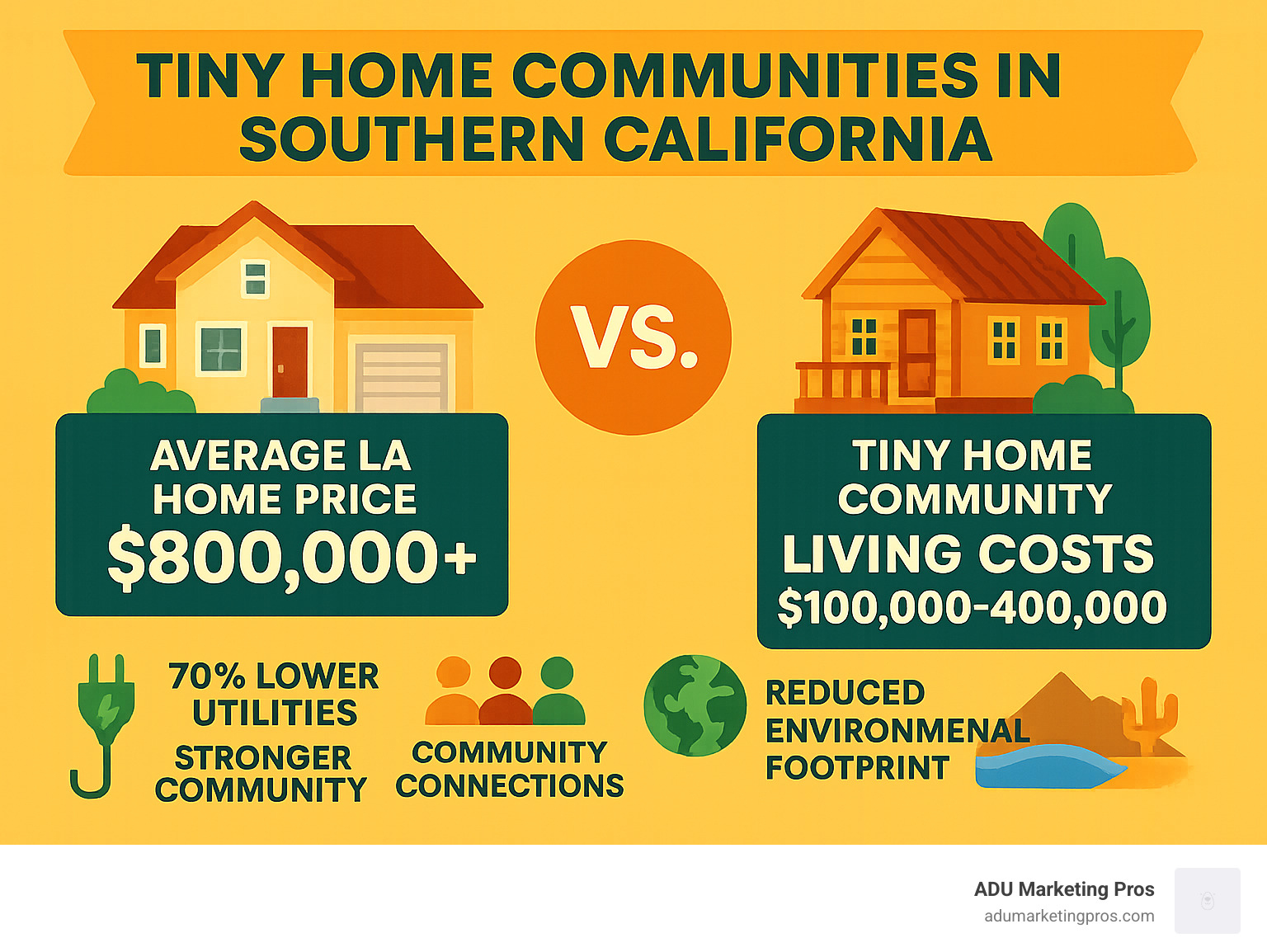
Why Choose a Tiny Home Community in Southern California?
Choosing tiny home communities in southern california is a strategic decision to embrace an affordable, high-quality lifestyle without forfeiting the dream of living in the Golden State. As the median home price continues its upward climb past the $800,000 mark, tiny homes present a practical and increasingly popular alternative that keeps the coveted California lifestyle within financial reach for a broader range of people, from first-time buyers to retirees.
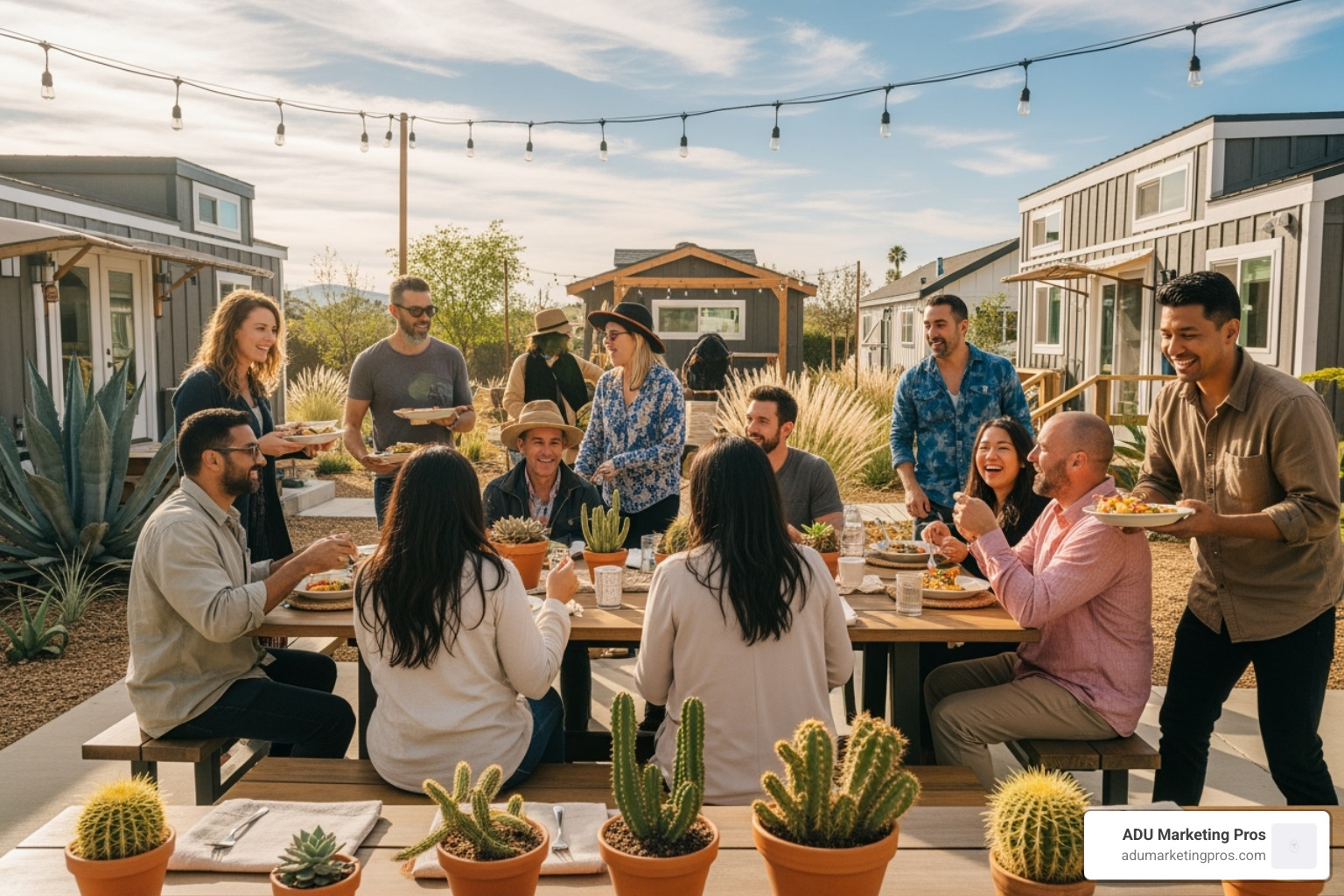
These communities are fundamentally about upsizing your life, not just downsizing your living space. You retain privileged access to Southern California’s unparalleled natural amenities—year-round sunshine, world-famous beaches, majestic mountains, and starkly beautiful deserts—but without the crushing financial strain that typically accompanies it. The region’s mild climate is exceptionally well-suited for tiny living, allowing for a seamless blend of indoor and outdoor life and turning your home into a cozy, efficient basecamp for an active, outdoor-centric lifestyle.
The Benefits of Community Living
The community aspect is often the most powerful and unexpected draw for new residents. Unlike the anonymity of many traditional neighborhoods, these villages are intentionally designed to foster a strong and supportive social fabric. Shared resources are a cornerstone of this model, with common features including community gardens, fully-equipped workshops, clubhouses, pools, and recreation centers. This infrastructure naturally creates a built-in social network, where spontaneous conversations and planned events like potlucks, group hikes, outdoor movie nights, and skill-sharing workshops become a regular part of life. This environment inherently promotes a greater sense of safety and security; it’s a modern-day version of a village where neighbors genuinely look out for one another, creating a robust support system that many people find missing in sprawling cities. Furthermore, group activities often crystallize around shared values, such as sustainability, fitness, or artistic pursuits, creating immediate and deep common ground among a diverse population of residents.
Affordability and Sustainability
From a financial perspective, tiny home communities are a complete game-changer. Instead of being saddled with a 30-year mortgage that dictates every life decision, you might have a small, manageable loan or own your home outright. With many new homes in communities starting in the low $100,000s, the barrier to entry is dramatically lower. The financial benefits continue to accrue long after the purchase. You’ll see significantly lower utility costs, as heating and cooling a 400-square-foot space is exponentially cheaper than managing a 2,000-square-foot house—often resulting in savings of 60-70%. Property taxes are also a fraction of what they would be on a traditional home.
This lifestyle is also inherently sustainable. Eco-friendly small homes require fewer resources to build, generate less construction waste, and consume less energy over their lifespan, resulting in a smaller environmental footprint. With less interior space, less consumption becomes a natural and liberating habit, which in turn reduces clutter and the mental stress associated with it. This newfound financial freedom is transformative, allowing residents to escape the immense pressures of California’s crazy real estate market and redirect their resources toward what truly matters to them, whether that’s investing, traveling, starting a business, or simply working less. The powerful combination of financial freedom and deep community connection creates a holistic lifestyle that prioritizes well-being, experiences, and personal growth over square footage.
Understanding the Types of Tiny Home Communities
Tiny home communities in southern california are not a monolithic concept; they are diverse and cater to a wide spectrum of lifestyles, budgets, and preferences. Understanding the key distinctions is the first step in finding the right fit. The primary classification divides them into communities for Tiny Homes on Wheels (THOWs), which are legally classified as recreational vehicles (RVs) and offer mobility, and those for tiny homes on permanent foundations, which are constructed like traditional houses and are often categorized as Accessory Dwelling Units (ADUs). Our detailed guide on ADU vs Tiny House can help you delve deeper into the legal and practical differences to determine which path is best for you.
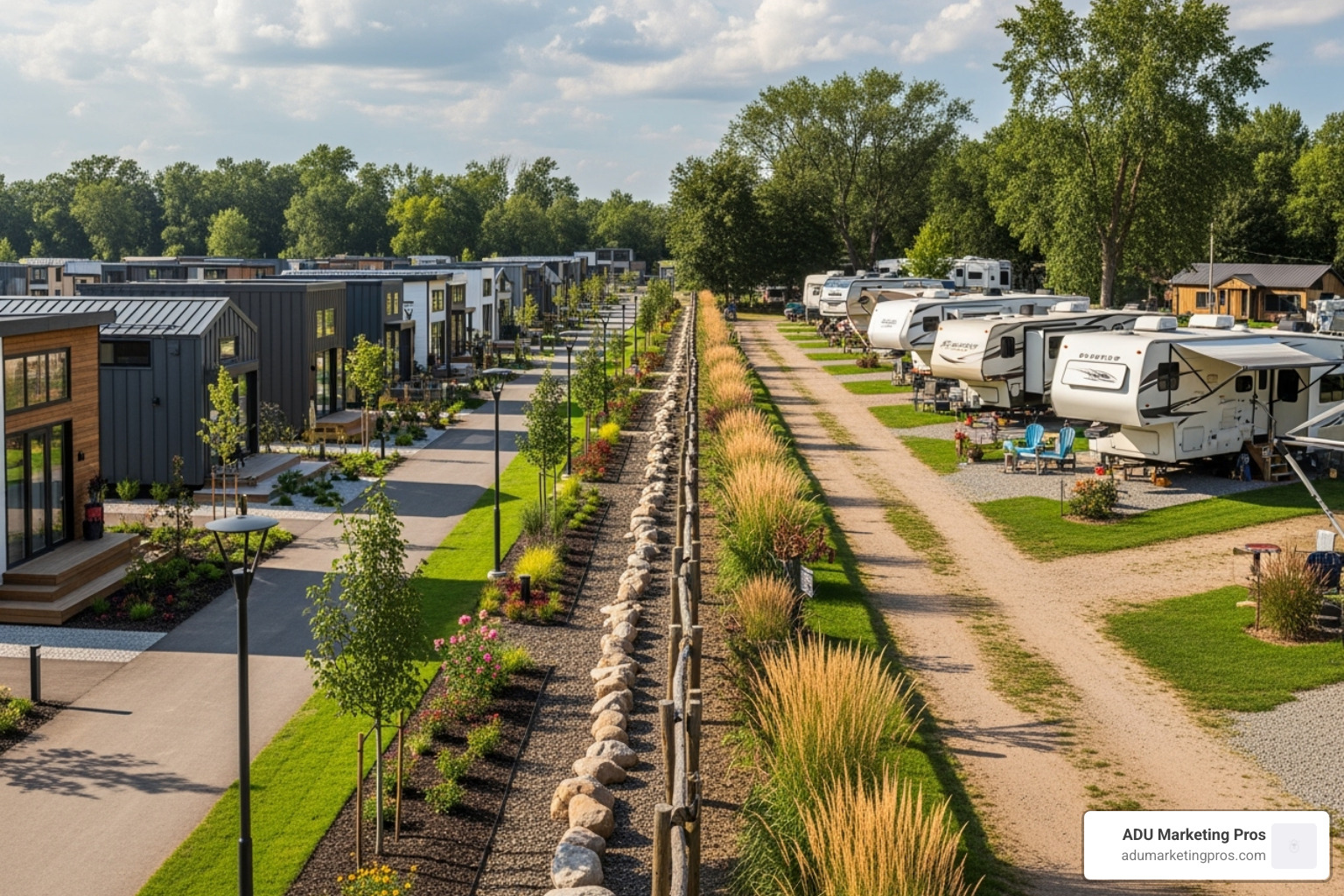
Dedicated Tiny Home Villages
These are master-planned, purpose-built communities designed from the ground up to support the tiny lifestyle. They are characterized by a strong community focus, with thoughtfully designed shared spaces like clubhouses, community kitchens, gardens, fire pits, and sometimes even co-working areas. Aesthetic standards are typically high, with architectural guidelines ensuring a cohesive and visually appealing environment that often feels more like a resort than a residential neighborhood. These villages provide permanent living solutions through long-term lot leases or, in some cases, the option to purchase the lot itself, offering stability and a true sense of place. While the monthly costs may be higher than in other settings, the enhanced quality of life, robust amenities, and palpable sense of community are significant draws for those seeking a long-term home.
RV Parks & Manufactured Home Communities
An accessible and widespread option, many existing RV parks and manufactured home communities across Southern California have opened their doors to tiny homes, particularly THOWs. This is often the most practical choice for tiny home dwellers who value mobility or are looking for more affordable lot rent. The primary benefit is the pre-existing infrastructure, including established hookups for water, sewer, and electricity, which dramatically simplifies the process of moving in. However, the overall experience can be quite different from a dedicated village. You’ll be part of a mixed housing environment, living alongside traditional RVs and older manufactured homes, which may not align with everyone’s aesthetic preferences. The transient population in many RV parks, with travelers coming and going, can also make it more challenging to build the deep, stable sense of community found in dedicated villages. It is absolutely critical to research each park’s specific THOW acceptance policies, as rules regarding home age, size, and certification (like RVIA) can vary dramatically.
Age-Restricted (55+) and Niche Communities
Beyond the general-purpose communities, you’ll find specialized villages designed to cater to specific demographics and interests. Age-restricted (55+) communities are particularly popular, especially in desirable retirement destinations like the Coachella Valley. These communities, such as those found in the top Southern California retirement cities, offer a quieter, more predictable environment with amenities tailored to active adults, such as clubhouses, golf courses, pickleball courts, and a full calendar of organized social events. Beyond age, a growing number of niche communities are forming around shared values and passions. You might find eco-conscious communities centered on permaculture and sustainable living, family-focused communities with playgrounds and kid-friendly programming, or even villages geared towards artists, equestrians, or digital nomads. These specialized enclaves foster incredibly deep connections among residents who share not just a zip code, but a common lifestyle and purpose.
Top Tiny Home Communities in Southern California for 2025
We’ve delved into the growing landscape of tiny home communities in southern california to spotlight the standout options for 2025. These are not merely places to park a tiny house; they are vibrant, thoughtfully designed communities where the promise of a better lifestyle is being realized every day.
Tiny House Block (Mount Laguna)
Tucked away at an elevation of 6,000 feet in the pine-covered mountains of San Diego County, Tiny House Block stands out as one of the few fully legal and permitted tiny home communities in the state. It offers a true four-season, nature-centric lifestyle where residents can literally hike the Pacific Crest Trail from their doorstep. The community welcomes both THOWs and foundation-built homes, fostering a close-knit atmosphere through its on-site Pine House Cafe and Tavern and communal fire pits, which serve as social hubs. It accommodates both short-term vacationers and long-term residents, creating a dynamic and diverse environment. Learn more about their unique mountain village at Tiny House Block.
Paradise Tiny Home Community (Desert Hot Springs)
Located in the sun-soaked Coachella Valley near Palm Springs, Paradise Tiny Home Community is a testament to the fact that tiny living can be both affordable and luxurious. With brand-new, stylish homes starting in the low $100,000s, it provides one of the most accessible entry points into the Southern California homeownership market. The resort-style amenities are a major attraction, featuring a sparkling swimming pool, a modern community gym, a beautifully remodeled clubhouse for events, and a pickleball court. This pet-friendly, all-ages community is welcoming and inclusive. It also allows residents to bring their own certified tiny home (under 399 sq ft and meeting current codes), offering flexibility. Find more details at Learn More About Paradise Tiny Home Community.
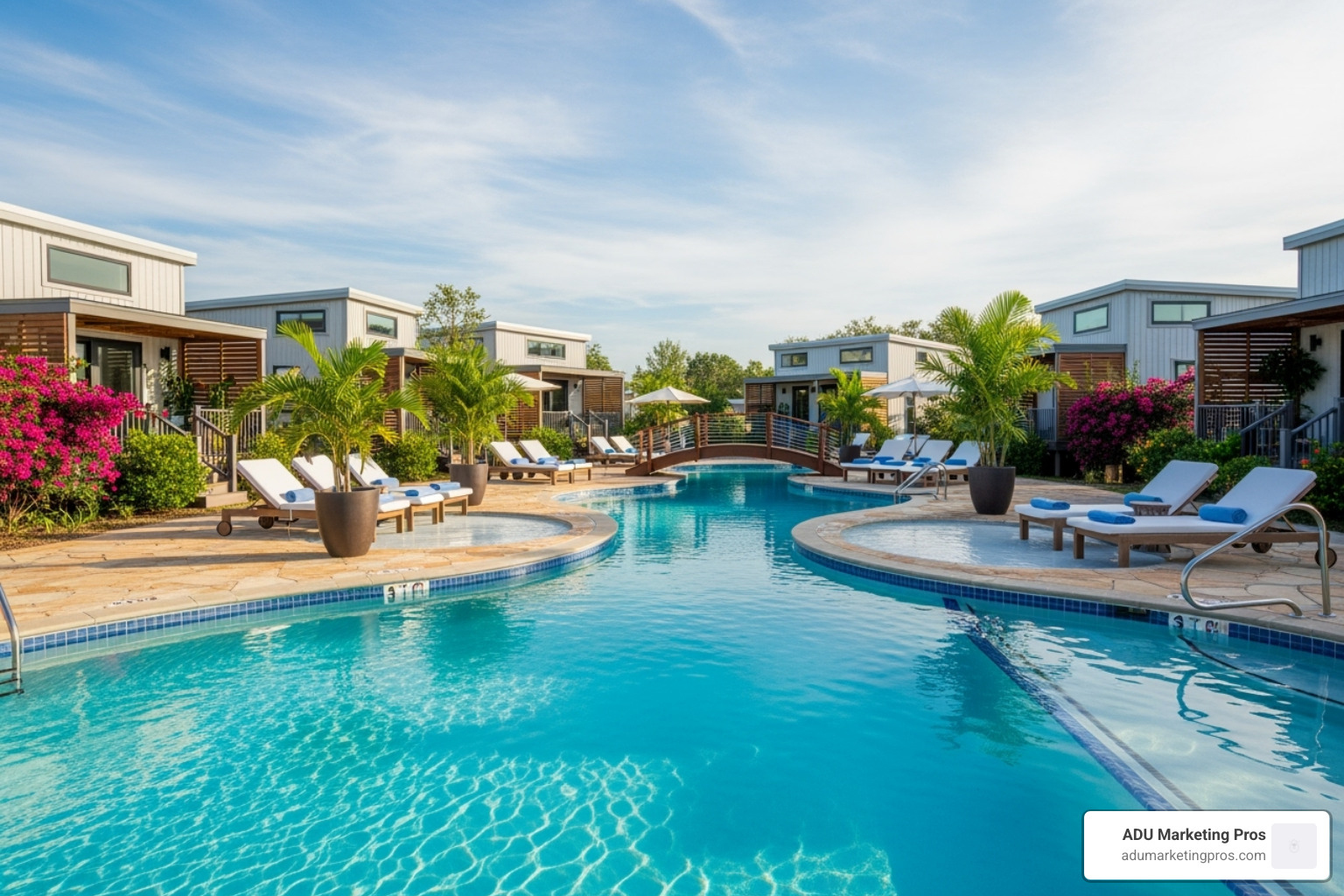
Palm Canyon Mobile Club (Palm Springs)
For those with an appreciation for design and a desire for mid-century modern sophistication, Palm Canyon Mobile Club is a premier tiny living destination. Situated in a prime Palm Springs location, it offers residents convenient access to the city’s famed restaurants, boutiques, and art galleries. Within the community, the resort-style clubhouse and pool area serves as a tranquil, stylish retreat. The community boasts a dynamic social scene with a mix of long-term residents and seasonal visitors, and regular social activities foster a vibrant, welcoming atmosphere. The entire community is built on a design philosophy that emphasizes clean lines, minimalist aesthetics, and seamless indoor-outdoor living—a perfect complement to the tiny home ethos. See their unique offerings at Palm Canyon Mobile Club.
Other Notable tiny home communities in southern california
-
Lemon Cove Village: Nestled near the entrance to Sequoia & Kings Canyon National Parks, this is an ideal community for outdoor adventurers and families. It offers a mix of RV sites and park model rentals, with amenities like a pool and clubhouse, making it a perfect basecamp for exploring the Sierra Nevada.
-
Royal Palms: Located in Cathedral City, this active 55+ community is perfect for retirees seeking a vibrant social life. The community calendar is packed with activities, from water aerobics in the pool to card games and potlucks in the clubhouse, all set against the backdrop of the stunning San Jacinto Mountains.
-
Oak Creek: A serene 55+ community in Coarsegold, this park offers a peaceful retreat with gorgeous mountain views and cooler temperatures. Its location provides proximity to the southern entrance of Yosemite National Park, making it a haven for nature lovers who appreciate a quiet, well-maintained environment.
-
Lake Perris Village: This all-ages community in Perris offers a tranquil living experience with beautifully manicured grounds and spacious lots. Its key advantage is its central location with convenient freeway access, making it easy to explore all of Southern California, from the beaches to the mountains to the deserts.
-
Valencia Travel Village: A great example of a well-established, high-end RV park in Castaic that is very friendly to Tiny Homes on Wheels (THOWs). It features multiple pools, a convenience store, and a robust community feel, offering a secure and amenity-rich option for THOW owners in Los Angeles County.
The Nitty-Gritty: Costs, Rules, and Finding Your Spot
While the dream of a simplified, community-oriented life is appealing, making the move to tiny home communities in southern california requires careful attention to the practical details. A realistic understanding of the costs, rules, and the process of finding a spot is crucial for a successful transition. Here’s a comprehensive look at what to expect.
Typical Costs to Expect
The financial breakdown for tiny living has several components. For those purchasing a home within a community, new models in places like Paradise Tiny Home Community start in the low $100,000s. If you’re buying a tiny home and the land it sits on, the average price across Southern California is approximately $313,810. However, most residents lease their lot. Monthly lot rent is the most significant recurring expense, typically ranging from $450 to over $1,200. This wide range is influenced by location (coastal-adjacent and prime desert spots are pricier) and the quality of amenities. On top of rent, you should budget for community fees or HOA dues ($50-$200/month), which cover the maintenance of common areas, as well as separate utility bills ($100-$300/month) and tiny home insurance ($50-$100/month). Even at the higher end, the total monthly cost is a fraction of traditional housing.
| Cost Factor | Tiny Home in Community | 1-Bedroom LA Apartment |
|---|---|---|
| Monthly Housing | $450 – $1,200+ | $2,000 – $3,000+ |
| Utilities | $100 – $300 | $150 – $400 |
| Community/HOA Fees | $50 – $200 | Often included |
| Insurance | $50 – $100 | $15 – $30 |
| Total Monthly | $650 – $1,800+ | $2,165 – $3,430+ |
For those interested in the ultimate freedom of owning their own parcel, our guide on Land for Sale in Southern California for Tiny Houses provides valuable insights into finding and purchasing land.
Navigating Legal and Zoning Regulations
This is often the most complex hurdle for aspiring tiny dwellers. Local regulations for tiny homes are a patchwork of different rules that vary significantly by city and county. Tiny Homes on Wheels (THOWs) are most often legally classified as RVs. This means they are generally restricted to long-term stays in designated RV parks or licensed tiny home communities. Cities like San Diego and Los Angeles have passed more progressive ordinances allowing THOWs as ADUs in residential backyards, but these are exceptions. Foundation-built tiny homes are typically treated as Accessory Dwelling Units (ADUs) and must comply with all local building codes, zoning, and permitting requirements, which often include size limits (usually under 500 sq ft). To ensure safety and insurability, many communities require RVIA certification for THOWs. This certification verifies that the home’s electrical, plumbing, and structural systems meet rigorous national safety standards. Always start by consulting the planning department of the specific city or county you’re interested in, as well as the California Department of Housing and Community Development (HCD) for state-level guidelines.
How to Find and Evaluate tiny home communities in southern california
Your search can begin with online directories, forums like Reddit’s r/tinyhouses, and social media groups. However, nothing replaces an in-person visit. This is the only way to truly gauge the community’s atmosphere, the condition of the facilities, and whether the vibe aligns with your personality. When you visit, schedule a meeting with community management. Come prepared with a list of questions about rules, all associated fees, the approval process for new residents, and any restrictions on home types. Most importantly, take the time to speak with current residents. Ask them for their honest feedback on management, the social environment, and the pros and cons of daily life there. If you plan to bring your own tiny home, get a written copy of the community’s acceptance criteria, including specific requirements for size, age, aesthetics, and necessary certifications.
Common Challenges and Considerations
Be prepared for a few realities of the tiny transition:
- Radical Downsizing: The process of shedding a lifetime of possessions can be emotionally and logistically challenging. Start early and be methodical.
- Small Space Dynamics: Living in close quarters requires creativity, organization (multi-functional furniture is key), and clear communication, especially if you have a partner or family.
- Legal Placement: Finding a legal, long-term spot for a THOW outside of an established community remains the single biggest challenge in California.
- Financing Hurdles: Traditional mortgages are not available for THOWs. You will likely need to secure a specialized RV loan, a chattel mortgage, or an unsecured personal loan, which may come with higher interest rates.
- Community Rules and Covenants: Living in a community means adhering to its rules. Be prepared for regulations on everything from quiet hours and pet policies to guest parking and exterior decorations.
Frequently Asked Questions about Tiny Home Living in SoCal
Here are detailed answers to the most common questions people have when considering a move to tiny home communities in southern california.
Can I bring my own tiny home to a community in Southern California?
Yes, many communities accept owner-brought homes, but there are almost always strict conditions. You cannot simply pull in any home you’ve built or bought. For instance, a community like Paradise Tiny Home Community requires homes to be under 399 square feet, recently built to current codes, and designed to match the community’s modern aesthetic. Most parks that accept Tiny Homes on Wheels (THOWs) will mandate RVIA (Recreational Vehicle Industry Association) certification to ensure the home meets safety standards for plumbing and electrical systems. Some may also have age restrictions, refusing to accept homes older than 5 or 10 years. The first step should always be to contact the community manager directly and get a written copy of their specific requirements before you purchase or move a home.
How much does it cost to live in a SoCal tiny home community?
Costs can be broken down into two main categories: upfront and recurring. The upfront cost of buying a new home within a community can range from the low $100,000s to over $200,000, depending on the model and finishes. If you buy a tiny home with its own land, the average all-in price is around $313,810. The primary recurring cost is the monthly lot rent, which typically falls between $450 and $1,200. This fee covers your space and access to common amenities. On top of that, you’ll pay for your own utilities (electricity, propane, internet) and any community or HOA fees. While not free, the total monthly outlay is significantly more affordable than renting an apartment or paying a mortgage on a traditional home in Southern California.
Are tiny homes legal everywhere in Southern California?
No, absolutely not. Legality is determined by a complex patchwork of local city and county zoning laws, which differ greatly from one jurisdiction to another. Tiny Homes on Wheels (THOWs) are most commonly classified as RVs, which means they are legally restricted to long-term placement in licensed RV parks or designated tiny home villages. In most places, you cannot legally park and live in a THOW in a residential backyard full-time. Foundation-built tiny homes are usually treated as Accessory Dwelling Units (ADUs), but they must still comply with all local building codes, permitting processes, and rules regarding size and placement on the property. This complicated and often confusing regulatory landscape is a primary reason why established tiny home communities are so popular—they have already navigated the legal hurdles, providing residents with a secure and fully legal place to live.
What are the financing options for a tiny home?
Securing financing for a tiny home, especially a THOW, is different from getting a traditional mortgage. Since THOWs are considered personal property (like an RV or vehicle) rather than real estate, they don’t qualify for conventional home loans. The most common financing routes include RV loans from specialized lenders, chattel mortgages (which use the home itself as collateral), or unsecured personal loans. Interest rates for these types of loans are typically higher than mortgage rates, and loan terms are shorter (usually 5-15 years). For foundation-built tiny homes classified as ADUs, it may be possible to use a home equity loan or a construction loan if you own the primary property.
Are there tiny home communities suitable for families with children?
Yes, while many communities are geared towards retirees or single adults, there are definitely all-ages communities that are great for families. Look for communities that specifically market themselves as “all-ages” or “family-friendly.” These villages, like Lemon Cove Village near the national parks, often feature amenities such as playgrounds, swimming pools, and open green spaces for kids to play. When evaluating a community, ask about its policies and observe the general demographic during your visit to see if other families and children are present, ensuring a welcoming environment for your own.
Conclusion
Living in a tiny home community in Southern California represents a profound shift in perspective. It’s about consciously choosing a lifestyle defined by freedom, community, and financial well-being over the conventional pursuit of square footage. It’s a practical and increasingly popular answer to the region’s housing affordability crisis, but its true value lies in the quality of life it unlocks. From the crisp mountain air of Mount Laguna to the sun-drenched, stylish deserts near Palm Springs, tiny home communities in southern california offer an achievable, sustainable, and deeply connected alternative to the status quo.
While the journey involves practical challenges—from the emotional task of downsizing to navigating a complex web of zoning regulations—the rewards are immense. The financial freedom gained from shedding a large mortgage can be life-altering, opening up possibilities for travel, passion projects, or early retirement. The built-in social network of a close-knit community provides a powerful antidote to the isolation of modern life. Whether you are drawn to the rustic, adventurous vibe of Tiny House Block, the resort-style amenities at Paradise Tiny Home Community, or the sophisticated design of Palm Canyon Mobile Club, there is a community in Southern California that can match your unique vision of home.
For those inspired to take the next step, whether by moving into an existing community or embarking on a custom tiny home or ADU project, the path requires careful planning and expert guidance. The design, permitting, and construction process can be complex, but you don’t have to do it alone. ADU Marketing Pros specializes in connecting aspiring homeowners with vetted, experienced builders and architects who understand California’s unique rules and can help transform your vision of a smaller, richer life into a tangible reality.
Ready to explore where your new adventure can begin? Dive deeper with our comprehensive guide on Places in Southern California That Allow Tiny Houses and start designing a life you truly love.

